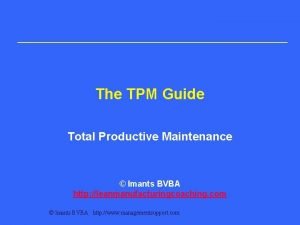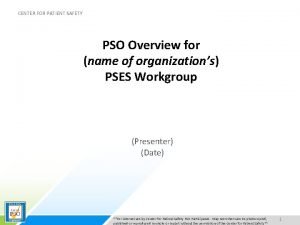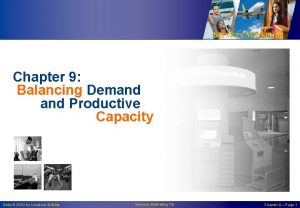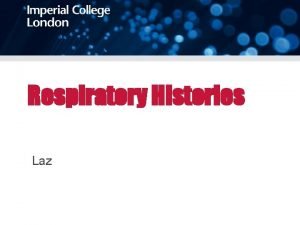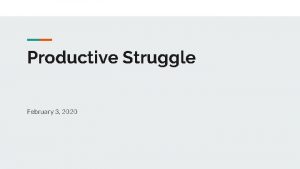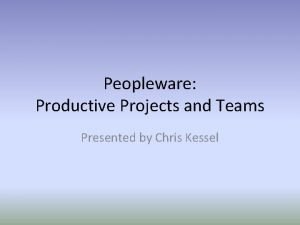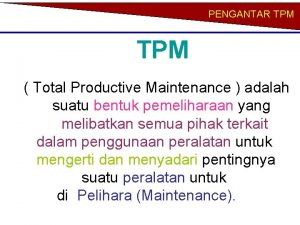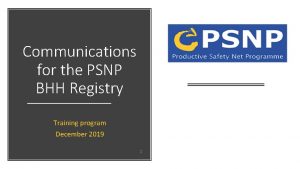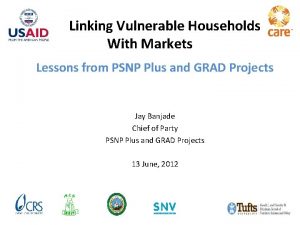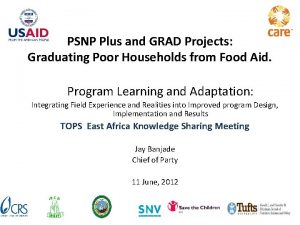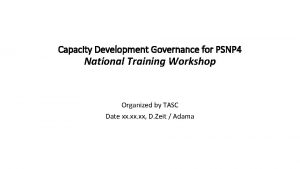Evaluation of Ethiopias Productive Safety Net Program PSNP









- Slides: 9

Evaluation of Ethiopia’s Productive Safety Net Program (PSNP) Alemayehu Seyoum Taffesse International Food Policy Research Institute (IFPRI) Evaluation Capacity Development (ECD) Workshop Independent Office of Evaluation (IOE) of IFAD Ministry of Agriculture and Natural Resources Ministry of Livestock and Fisheries Agriculture Transformation Agency 6 th November 2015, Washington Hotel, Addis Ababa, Ethiopia

Outline q The PSNP § Description, § Impact – food security, productivity; q Impact Evaluation of the PSNP (Highlands) § Evaluation design, § Evaluation implementation; § Performance and Impact measures

The PSNP – Basic Features q Motivation § the drought of 2002 -03; § New Coalition for Food Security in Ethiopia (2003) q Features § Predictability - multi-year planning and financing; § Coordination and commitment – donors (9), government; § Combine transfers with asset building – PW plus direct support ; § Integrated with the broader development agenda; § Targeting – Geographic, Community § Large: o Beneficiaries - Up to 8 million persons, nearly 300 woredas (40%); o Cost - US$1. 5 billion (2005 -09); US$2. 1 billion (2010 -14)

The PSNP – Evaluation Design q Monitoring and evaluation: § a part of the initial design and mutual understanding; § independent but collaborative – government, donors, the national statistical agency, external evaluators; § interim rigorous evaluations o Every two years starting 2006; o Assess both process (performance) and outcome (impact); o Five until 2014 (fifth being the final for PSNP 3);

The PSNP – Evaluation Design q Methodology § Data o panel household survey of beneficiaries and non-beneficiaries from the same EAs; o community and woreda sureys o qualitative study undertaken in 10 woredas - key informant interviews, focus group discussions, household case studies o considerable effort to ensure comparability over time – Survey time, core questions, core team (JH, AST, YY) same since 2006 § Approaches o Matching o Instrumental variables

The PSNP – Process Measures q Rigorous evaluations; § Channel 1 – create opportunities to learn and adjust o Good targeting; o Arrears – Payroll and Attendance Sheet System (PASS), Client cards); o The case of nutrition; o Still learning § Channel 2 – help bridge results-based budgeting and longer term programming designed to achieve impact;

The PSNP – Outcome Measures q Impact (latest results) § Reduced months of food insecurity (food gap) § Improved household diet diversity (food groups) § Increased per capita food and total consumption (expenditure); § Increased household livestock holdings (TLU); § Raised the likelihood of improving housing conditions (corrugated iron sheet roofs) § Faster yield growth due to community assets created via PSNP; § Local economy (general equilibrium) effects – growth;

References Reports – 2007, 2009, 2011, 2013, 2015 (in progress). Journal Articles q Berhane et. al (2014). Economic Development and Cultural Change, volume 63: 1, 2014, pages 1 -26. q Hoddinott, et. al (2012). Journal of African Economies, Volume 21, Issue 5, pp. 761786. q Gilligan, Hoddinott, and Taffesse (2009). Journal of Development Studies, Volume 45, Issue 10, 2009, pp. 1684– 1706. Book chapters q Hoddinott et. al (2013) in Rahmato, Dessalegn, Alula Pankrust, and Jan-Gerrit van Uffelen, Food Security, Safety Nets and Social Protection in Ethiopia, Forum for Social Studies. q Coll-Black et. al (2012) in Dorosh, Paul, and Shahidur Rashid (eds. ), Food and Agriculture in Ethiopia: Progress and Policy Challenges, University of Pennsylvania Press (in collaboration with IFPRI). q Hoddinott, Gilligan, and Taffesse (2010) in Sudhanshu Handa, Stephen Devereux, and Doug Webb, eds. Social Protection for Africa’s Children, (Routledge).

Thank You 9
 Seven pillars of tpm
Seven pillars of tpm Patient safety evaluation system
Patient safety evaluation system Classification of suffixes
Classification of suffixes Variations in demand relative to capacity
Variations in demand relative to capacity Acute productive cough differential diagnosis
Acute productive cough differential diagnosis Productive persistence definition
Productive persistence definition Define productive struggles
Define productive struggles Peopleware: productive projects and teams
Peopleware: productive projects and teams Total productive maintenance ppt
Total productive maintenance ppt Allocative efficiency vs productive efficiency
Allocative efficiency vs productive efficiency
